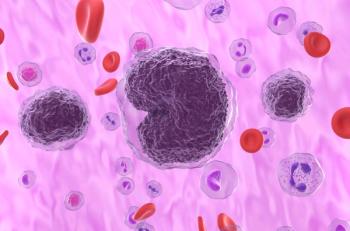
- July 2025
- Volume 31
- Issue Spec. No. 8
- Pages: SP492-SP493
Zanubrutinib Shows Durable Benefit for High-Risk CLL/SLL at 5 Years in SEQUOIA Trial
Key Takeaways
- Zanubrutinib demonstrated a 5-year progression-free survival (PFS) rate of 72.2% and overall survival rate of 85.1% in patients with deletion of the 17p chromosome (del[17p]) chronic lymphocytic leukemia (CLL) or small lymphocytic lymphoma.
- The treatment was well-tolerated, with no new safety signals, and most patients continued therapy.
Zanubrutinib showed long-term efficacy in patients with chronic lymphocytic leukemia (CLL) or small lymphocytic lymphoma (SLL) and deletion of the 17p chromosome, with progression-free survival similar to patients without high-risk disease characteristics.
First-line zanubrutinib (Brukinsa; BeiGene) monotherapy demonstrated durable clinical benefits and manageable safety in patients with
Zanubrutinib, a next-generation Bruton tyrosine kinase inhibitor approved for multiple B-cell malignancies, including CLL/SLL,2 previously demonstrated superior progression-free survival (PFS) vs standard chemoimmunotherapy in patients without del(17p) and encouraging PFS and overall response rate (ORR) in those with del(17p).1
The new data presented at ASCO focus on arm C of the SEQUOIA trial, which includes a nonrandomized cohort of 111 patients with del(17p) treated with zanubrutinib monotherapy. The median age in the cohort was 71 years, with 71% male patients. Sixty percent of patients had unmutated IGHV, and 42% had TP53 mutations, both of which are associated with more aggressive disease.3,4
At a median follow-up of 65.8 (range, 5-75) months, median PFS was not reached.1 The 5-year estimated PFS rate was 72.2% (62.4%-79.8%), or 73.0% (63.3%-80.6%) after adjustment for COVID-19–related factors. While OS was also not reached, the 5-year estimated OS rate was 85.1% (76.9%-90.6%), or 87.0% (79.0%-92.1%) after COVID-19 adjustment. The ORR was 97.3%, with 18.2% of patients experiencing complete response (CR) or CR with incomplete hematologic recovery.
“This is the largest cohort ever of patients with del(17p) CLL treated with a single therapy on a prospective study, and at a median follow-up of 5 years, the progression-free survival is 72.2%, which is not different from patients without del(17p) treated on the same study,” first author and presenter Constantine S. Tam, MD, MBBS, head of lymphoma service at Alfred Hospital and professor of hematology at Monash University in Melbourne, Australia, said while presenting the data at ASCO. “This really highlights the ability of zanubrutinib to neutralize the risk of del(17p) CLL in the front line.”
The majority of patients (62.2%) were still receiving zanubrutinib at the time of the analysis, and no new safety signals were identified. The most common causes of treatment discontinuation were adverse events (AEs; 17.1%) and progressive disease (15.3%). Noted AEs of interest regardless of severity included infection (82%), bleeding (60%), neutropenia (19%), hypertension (18%), anemia (9%), thrombocytopenia (8%), and atrial fibrillation/flutter (7%). Grade 3 or higher AEs included infection (33%), neutropenia (16%), hypertension (8%), bleeding (6%), atrial fibrillation/flutter (5%), and thrombocytopenia (2%).
The 5-year follow-up data highlight the efficacy of zanubrutinib in treatment-naive higher-risk patients with del(17p) in the long term, as patients continued to demonstrate PFS benefits that were consistent with those seen in patients without del(17p) in arm A of the trial, the authors concluded.
“I believe that this is a foundational cohort of patients, which is far larger than the experience of ibrutinib and acalabrutinib put together in the same population, and it sets a new benchmark for the treatment of del(17p) CLL,” Tam concluded, again noting the similar PFS between patients with and without del(17p) in the SEQUOIA trial as well as superior PFS with zanubrutinib vs ibrutinib in the ALPINE study.1,5 “Collectively, these data suggest that zanubrutinib is a highly efficacious drug in CLL capable of neutralizing the traditional risk factors associated with poor prognosis in this disease.”
References
1. Tam CS, Ghia P, Shadman M, et al. SEQUOIA 5-year follow-up in arm C: Frontline zanubrutinib monotherapy in patients with del(17p) and treatment-naive chronic lymphocytic leukemia/small lymphocytic lymphoma (CLL/SLL). J Clin Oncol. 2025;43(suppl 16). doi:10.1200/JCO.2025.43.16_suppl.7011.
2. Brukinsa. Prescribing Information. BeiGene;2025. Accessed June 6, 2025.
3. Rotbain EC, Frederiksen H, Hjalgrim H, et al. IGHV mutational status and outcome for patients with chronic lymphocytic leukemia upon treatment: a Danish nationwide population-based study. Haematologica. 2020;105(6):1621-1629. doi:10.3324/haematol.2019.220194
4. Campo E, Cymbalista F, Ghia P, et al. TP53 aberrations in chronic lymphocytic leukemia: an overview of the clinical implications of improved diagnostics. Haematologica. 2018;103(12):1956-1968. doi:10.3324/haematol.2018.187583
5. Brown JR, Eichhorst B, Lamanna N, et al. Sustained benefit of zanubrutinib vs ibrutinib in patients with R/R CLL/SLL: final comparative analysis of ALPINE. Blood. 2024;144(26):2706-2717. doi:10.1182/blood.2024024667
Articles in this issue
Newsletter
Stay ahead of policy, cost, and value—subscribe to AJMC for expert insights at the intersection of clinical care and health economics.













































